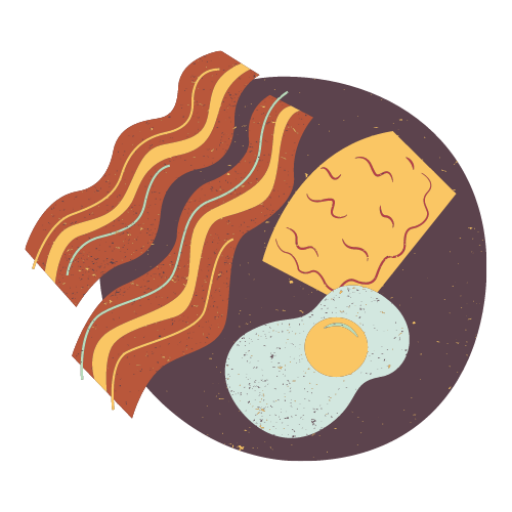Paleo breakfast options offer a nutritious start to the day without relying on grains, dairy, or processed foods. These recipes embrace wholesome ingredients like eggs, meats, vegetables, fruits, and nuts to create satisfying morning meals that align with ancestral eating principles.
By exploring naturally paleo breakfast recipes, individuals can discover new flavors and textures while maintaining their dietary preferences. From hearty vegetable hashes to protein-packed chia seed puddings, these dishes provide a variety of options to suit different tastes and time constraints. Embracing paleo breakfast recipes can help kickstart a day of clean eating and support overall wellness goals.
1) Avocado and Smoked Salmon Salad
This paleo-friendly breakfast combines the richness of avocado with the smoky flavor of salmon. It’s a nutritious and satisfying way to start the day.
To prepare, slice a ripe avocado and arrange it on a plate with thin strips of cold-smoked salmon. Add sliced cucumber for a refreshing crunch.
For extra flavor, squeeze fresh lemon juice over the salad. Sprinkle with dill and a pinch of sea salt. If desired, include some red onion for a sharp contrast.
This dish is packed with healthy fats from both the avocado and salmon. It’s also high in protein, making it an excellent choice for those following a paleo diet.
The salad can be customized with additional paleo-approved ingredients. Consider adding sliced grapefruit or blood oranges for a citrusy twist.
This quick and easy breakfast requires no cooking, perfect for busy mornings. It’s also versatile enough to serve as a light lunch or dinner.
2) Sweet Potato Hash with Eggs

Sweet potato hash with eggs is a delicious and nutritious paleo breakfast option. This dish combines the natural sweetness of sweet potatoes with savory eggs for a satisfying meal.
To prepare this dish, start by dicing sweet potatoes and cooking them in a skillet with coconut oil or ghee. Add spices like cinnamon or paprika for extra flavor.
Once the sweet potatoes are tender and lightly browned, create wells in the hash and crack eggs directly into them. Cover the skillet and cook until the egg whites are set but the yolks remain runny.
For added protein, some recipes incorporate crumbled breakfast sausage or bacon. These can be cooked first, then set aside while the sweet potatoes cook in the remaining fat.
Variations of this dish may include additional vegetables like bell peppers or onions for more texture and nutrients. Herbs such as rosemary or thyme can also enhance the flavor profile.
This paleo-friendly breakfast is not only tasty but also provides a good balance of carbohydrates and protein to start the day. It’s easily customizable to suit individual preferences and dietary needs.
3) Coconut Flour Pancakes
Coconut flour pancakes offer a delicious paleo-friendly breakfast option. These light and fluffy pancakes are made with nutrient-rich coconut flour, providing a low-carb alternative to traditional wheat-based recipes.
The basic ingredients for coconut flour pancakes typically include eggs, coconut oil, honey, coconut milk, and coconut flour. Some recipes incorporate additional flavors like vanilla extract or mashed banana for natural sweetness.
To achieve the best texture, it’s important not to overmix the batter. Coconut flour absorbs liquid quickly, so allowing the batter to rest for a few minutes before cooking can help improve consistency.
Cooking these pancakes requires a bit more care than regular pancakes. Using a well-greased skillet over medium-low heat helps prevent sticking. Smaller pancakes are easier to flip and less likely to fall apart.
Coconut flour pancakes pair well with various toppings. Fresh fruit, chopped nuts, or a drizzle of maple syrup can complement their subtle coconut flavor. For those seeking extra protein, adding a scoop of almond butter provides a nutritious boost.
4) Banana Almond Butter Smoothie
This simple yet satisfying smoothie combines the natural sweetness of bananas with the rich, creamy texture of almond butter. It’s a quick and easy breakfast option that adheres to paleo principles.
The recipe typically calls for frozen bananas, almond butter, and a non-dairy milk like almond milk. Some variations include additional ingredients such as non-dairy yogurt, vanilla extract, or a touch of cinnamon for extra flavor.
To prepare the smoothie, add all ingredients to a blender and blend until smooth and creamy. If the consistency is too thick, a splash of additional milk can be added. For a colder drink, ice cubes can be incorporated during blending.
This smoothie is naturally sweetened by the banana, but some recipes suggest adding a small amount of maple syrup for those who prefer a sweeter taste. The paleo-friendly ingredients provide a good balance of healthy fats, carbohydrates, and nutrients.
For added texture and visual appeal, the smoothie can be topped with a drizzle of almond butter, sliced almonds, or a sprinkle of cinnamon before serving. This breakfast smoothie is not only delicious but also filling and energizing.
5) Zucchini and Bacon Fried Eggs

This hearty breakfast combines the savory flavors of bacon with the freshness of zucchini and the protein-rich goodness of eggs. It’s a simple yet satisfying paleo-friendly meal to start the day.
Begin by cooking bacon in a skillet until crispy. Remove the bacon and set aside, leaving the rendered fat in the pan. Grate zucchini and squeeze out excess moisture using a clean kitchen towel.
Add the shredded zucchini to the pan with bacon fat and sauté until it becomes tender and slightly golden. Create small wells in the zucchini mixture and crack eggs into these spaces.
Cook the eggs to your desired level of doneness. For runny yolks, cover the pan and cook for about 3-4 minutes. If you prefer firmer yolks, cook for an additional 1-2 minutes.
Crumble the reserved bacon and sprinkle it over the eggs and zucchini. Season with salt and pepper to taste. Serve hot, straight from the skillet for a rustic and delicious paleo breakfast.
6) Chia Seed Pudding with Berries

Chia seed pudding with berries offers a delicious and nutritious paleo breakfast option. This simple dish combines chia seeds with non-dairy milk, creating a creamy pudding-like texture overnight.
To prepare, mix chia seeds with coconut milk or almond milk in a jar. Add a touch of vanilla extract for flavor. Stir well and refrigerate for at least 8 hours or overnight.
The chia seeds absorb the liquid, expanding to form a thick pudding. In the morning, top the pudding with fresh berries such as strawberries, blueberries, or raspberries.
For added sweetness, drizzle with a small amount of maple syrup or honey. Some recipes incorporate pureed berries into the pudding mixture for a fruity twist.
This breakfast is rich in omega-3 fatty acids, fiber, and antioxidants. It provides sustained energy and helps maintain stable blood sugar levels throughout the morning.
Chia seed pudding can be prepared in advance, making it a convenient grab-and-go breakfast option for busy mornings. It’s customizable with various fruit toppings and flavor additions.
7) Almond Flour Muffins

Almond flour muffins offer a delicious paleo-friendly breakfast option. These muffins are naturally gluten-free and grain-free, making them suitable for those following a paleo diet.
The base ingredients typically include almond flour, eggs, and a natural sweetener like maple syrup or honey. Baking powder and baking soda help the muffins rise, while cinnamon adds warmth and flavor.
Many recipes incorporate grated apple or applesauce for moisture and natural sweetness. Coconut oil is often used as a healthy fat source, contributing to the muffins’ tender texture.
For added nutrition and flavor, some variations include shredded carrots, nuts, or dried fruits. These ingredients transform simple almond flour muffins into nutrient-dense morning glory muffins.
Preparation is straightforward. Dry ingredients are mixed separately from wet ingredients before combining. The batter is then scooped into lined muffin tins and baked at a moderate temperature, usually around 325-350°F.
Almond flour muffins are versatile and can be customized with various mix-ins. They provide a satisfying, protein-rich breakfast that aligns with paleo principles while offering the comfort of a traditional baked good.
8) Egg and Spinach Breakfast Wraps

Egg and spinach breakfast wraps offer a protein-packed, nutrient-rich start to the day that aligns perfectly with paleo principles. These wraps use large, thin egg “tortillas” as a grain-free alternative to traditional flour wraps.
To create the egg wrap, whisk an egg and pour it into a heated, oiled non-stick pan. Swirl the pan to spread the egg into a thin layer, cooking it like a crepe.
Once set, the egg wrap can be filled with sautéed spinach, which provides iron and vitamins. Other paleo-friendly additions might include diced avocado for healthy fats, and sliced mushrooms for extra texture and nutrients.
For those seeking additional protein, cooked and crumbled bacon or diced chicken can be incorporated. Season the filling with herbs like basil or thyme to enhance flavor without adding unnecessary ingredients.
These wraps are not only delicious but also convenient for on-the-go mornings. They can be prepared in advance and reheated, making them an excellent option for meal prep.
9) Cashew Yogurt Parfait

Cashew yogurt parfait offers a delightful paleo-friendly breakfast option. This dish combines the creamy texture of cashew-based yogurt with layers of fresh fruits and crunchy toppings.
To create the yogurt, cashews are soaked and blended until smooth. The mixture is then fermented to achieve a tangy flavor similar to traditional yogurt. This process ensures a dairy-free alternative that aligns with paleo guidelines.
The parfait is assembled by layering the cashew yogurt with a variety of paleo-approved ingredients. Mixed berries, such as strawberries, blueberries, and raspberries, provide natural sweetness and essential nutrients.
For added crunch and nutritional benefits, chia seeds and pumpkin seeds are sprinkled between layers. These seeds offer omega-3 fatty acids and protein, enhancing the parfait’s nutritional profile.
The final product is a visually appealing and nutritious breakfast. It provides a balance of healthy fats, proteins, and carbohydrates, making it a satisfying meal to start the day.
10) Paleo Granola with Nuts
Paleo granola with nuts offers a crunchy, satisfying breakfast option that adheres to paleo dietary principles. This grain-free alternative replaces traditional oats with a variety of nuts and seeds.
Common ingredients include almonds, walnuts, pecans, and cashews. Pumpkin seeds and sunflower seeds often add extra crunch and nutritional value. Coconut flakes or chips frequently feature in paleo granola recipes as well.
To bind the ingredients, most recipes use a combination of coconut oil and natural sweeteners like honey or maple syrup. Cinnamon and vanilla extract contribute warmth and flavor to the mix.
Preparation typically involves mixing the dry ingredients, then coating them with the melted oil and sweetener blend. The mixture is spread on a baking sheet and baked at a low temperature, usually around 300-320°F (150-160°C).
Stirring the granola every 10-15 minutes during baking ensures even cooking and prevents burning. The total baking time generally ranges from 20 to 40 minutes, depending on the recipe and desired crispness.
Once cooled, paleo granola can be stored in an airtight container for up to a week. It serves as a versatile breakfast food, eaten on its own or paired with non-dairy milk or yogurt alternatives.
11) Veggie Omelet

A veggie omelet is a versatile and nutritious paleo breakfast option. It combines protein-rich eggs with an array of colorful vegetables for a satisfying meal.
Popular vegetable choices include spinach, mushrooms, bell peppers, and onions. These can be sautéed in olive oil or coconut oil before adding the beaten eggs.
For extra flavor, consider incorporating herbs like basil, parsley, or chives. Some paleo-friendly additions include sundried tomatoes or hemp seeds for added texture and nutrients.
The cooking technique is crucial for a perfect omelet. Use a non-stick skillet over medium heat to ensure even cooking. Pour the beaten eggs into the pan, then add the pre-cooked vegetables.
As the edges set, gently lift them to allow uncooked egg to flow underneath. Once the omelet is mostly set, fold it in half and serve immediately.
This dish is not only compliant with paleo guidelines but also provides a balanced mix of proteins and vegetables to start the day.
12) Paleo Banana Bread
Paleo banana bread offers a grain-free twist on a classic breakfast favorite. This moist and flavorful treat uses almond flour or coconut flour as a base instead of wheat flour.
Ripe bananas provide natural sweetness, while eggs act as a binder. Many recipes incorporate almond butter or coconut oil for added richness and texture.
Cinnamon and vanilla extract enhance the bread’s warm, comforting flavor profile. Some versions include chopped nuts or dark chocolate chips for extra crunch and taste.
Baking paleo banana bread is straightforward. Ingredients are mixed, poured into a loaf pan, and baked until golden brown. The result is a tender, satisfying bread that’s free from grains, dairy, and refined sugars.
This versatile recipe can be enjoyed as a quick breakfast, snack, or dessert. It’s easily customizable to suit individual preferences while maintaining its paleo-friendly status.
13) Hearty Beef and Veggie Stew
A hearty beef and veggie stew makes for a satisfying paleo breakfast option. This protein-rich dish combines tender chunks of beef with an array of nutritious vegetables.
Start by browning grass-fed beef in a large pot. Add onions, garlic, and celery, cooking until fragrant. Incorporate carrots, sweet potatoes, and other paleo-friendly root vegetables for added texture and flavor.
Pour in beef broth and tomatoes to create a rich base. Season with herbs like rosemary and thyme for depth. Simmer the stew until the meat is tender and the vegetables are cooked through.
For extra flavor, consider adding bacon or prunes to the mix. These ingredients complement the savory notes of the beef and add a touch of sweetness.
This stew can be prepared in advance and reheated for a quick, nourishing breakfast. It’s packed with protein and vegetables, providing a balanced start to the day.
Serve the stew hot, garnished with fresh herbs if desired. This hearty meal will keep you full and energized throughout the morning.
14) Mixed Berry Smoothie Bowl

A mixed berry smoothie bowl offers a delicious and nutrient-dense paleo breakfast option. This vibrant dish combines frozen berries and banana as its base, creating a thick, creamy texture.
The smoothie mixture is blended until it reaches a soft-serve consistency. It’s then poured into a bowl, ready for toppings. Popular paleo-friendly additions include shredded coconut, fresh berries, and flax seeds.
For added protein and healthy fats, a spoonful of nut butter can be incorporated into the blend. Almond or cashew butter work well with the fruity flavors. Some recipes also suggest adding collagen powder for an extra protein boost.
To keep the smoothie bowl paleo-compliant, it’s made with non-dairy milk alternatives. Unsweetened almond, coconut, or cashew milk are excellent choices. These options maintain the creamy texture without introducing non-paleo ingredients.
The mixed berry smoothie bowl is not only visually appealing but also packed with vitamins and antioxidants from the berries. It provides a refreshing start to the day while adhering to paleo principles.
15) Paleo Sweet Potato Toast
Sweet potato toast offers a nutritious and grain-free alternative to traditional bread-based toast. This paleo-friendly breakfast option is simple to prepare and versatile in its toppings.
To make sweet potato toast, slice a sweet potato lengthwise into 1/4-inch thick slabs. These slices can be cooked in a toaster, air fryer, or oven until tender and lightly browned.
Oven preparation involves preheating to 350°F and placing the slices on a wire rack over a baking sheet. Brush each slice lightly with olive oil before baking for about 20-25 minutes.
Once cooked, the sweet potato slices serve as a base for various toppings. Popular paleo-friendly options include mashed avocado, sliced bananas, almond butter, or smoked salmon.
For added protein, consider topping with a fried egg or nitrate-free bacon. Fresh berries or a drizzle of honey can satisfy those with a sweet tooth while maintaining paleo principles.
Sweet potato toast provides a good source of complex carbohydrates, fiber, and vitamins. It’s an excellent choice for those following a paleo diet or looking to incorporate more vegetables into their breakfast routine.
The Paleo Diet Explained

The Paleo diet aims to mimic the eating habits of our hunter-gatherer ancestors. It focuses on whole, unprocessed foods that were available in prehistoric times, emphasizing nutrient-dense options and eliminating modern processed products.
Principles of Paleo Nutrition
The Paleo diet emphasizes consuming whole foods that were available to our ancestors. This includes:
- Lean meats and fish
- Fruits and vegetables
- Nuts and seeds
- Healthy fats like avocado and olive oil
Foods to avoid on the Paleo diet:
- Grains (wheat, oats, rice)
- Legumes (beans, lentils)
- Dairy products
- Processed foods and refined sugars
The diet encourages eating grass-fed meats, wild-caught fish, and organic produce when possible. It also promotes cooking with natural fats like coconut oil and ghee.
Benefits of Paleo Eating
Adopting a Paleo diet may lead to several health benefits:
Weight loss: The focus on whole foods and protein can increase satiety and reduce calorie intake.
Improved blood sugar control: Eliminating refined carbs may help stabilize blood glucose levels.
Reduced inflammation: The diet’s emphasis on anti-inflammatory foods may alleviate symptoms of certain autoimmune conditions.
Increased nutrient intake: Consuming nutrient-dense whole foods can improve overall nutrition.
Better digestive health: Eliminating processed foods and grains may reduce digestive issues for some individuals.
Many people report increased energy levels and improved sleep quality when following a Paleo diet. However, individual results may vary, and it’s important to consult a healthcare professional before making significant dietary changes.
Key Ingredients for Paleo Breakfasts

Paleo breakfasts rely on nutrient-dense whole foods that align with ancestral eating patterns. Certain key ingredients form the foundation for creating satisfying and nourishing paleo morning meals.
Natural Sweeteners
Paleo-friendly sweeteners add flavor without refined sugars. Honey offers antimicrobial properties and trace minerals. Pure maple syrup contains antioxidants and minerals like zinc and manganese. Dates provide fiber and potassium. Coconut sugar has a lower glycemic index than regular sugar.
These natural options work well in baked goods, smoothies, and oatmeal alternatives. Use them sparingly, as the paleo diet aims to reduce overall sugar intake. Mashed bananas or applesauce can also add natural sweetness to recipes.
Grain-Free Alternatives
Paleo breakfasts exclude grains but offer nutrient-rich substitutes. Almond flour and coconut flour replace wheat in baked goods. They’re high in protein and fiber. Cassava flour works well for pancakes and waffles.
Cauliflower rice serves as a base for savory breakfast bowls. Spiralized vegetables like zucchini create noodle-like textures. Sweet potatoes offer a starchy alternative to grains and pair well with eggs and vegetables.
Chia seeds and flaxseeds add omega-3 fatty acids and fiber to breakfast puddings and porridges. They create gel-like textures when soaked, mimicking traditional breakfast cereals.
Balancing Macronutrients in Paleo Meals

Paleo breakfast recipes aim to optimize macronutrient balance. Focusing on proteins and healthy fats while limiting carbohydrates helps maintain stable energy levels and supports overall health.
Importance of Proteins
Protein plays a crucial role in Paleo breakfasts. It provides essential amino acids for muscle repair and growth. Eggs are a popular protein source, offering versatility and nutrients. A breakfast bake with sausage and vegetables delivers a protein-packed start to the day.
Lean meats like turkey or chicken can be incorporated into morning meals. Fish, rich in omega-3 fatty acids, serves as another excellent protein option. For vegetarians following a Paleo diet, nuts and seeds can supplement protein intake.
Protein helps increase satiety, potentially reducing overall calorie consumption throughout the day. Aim for 20-30 grams of protein at breakfast to support metabolism and maintain muscle mass.
Healthy Fats in Paleo
Healthy fats are a cornerstone of Paleo nutrition. They provide sustained energy and support hormone production. Avocados, rich in monounsaturated fats, make an excellent addition to Paleo breakfasts.
Nuts and seeds offer a mix of healthy fats and protein. Almonds, walnuts, and chia seeds can be sprinkled on Paleo-friendly cereals or added to smoothies. Coconut oil and olive oil are preferred cooking fats in Paleo cuisine.
Eggs, particularly the yolks, contain beneficial fats and nutrients. Grass-fed butter or ghee can be used in moderation by those following a less strict Paleo approach. Including a variety of healthy fats helps ensure a well-rounded nutritional profile in Paleo breakfast meals.




